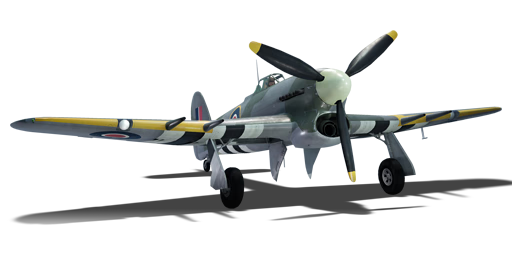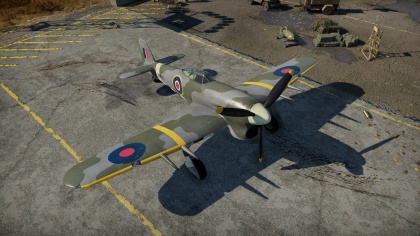Typhoon Mk Ib
Contents
| This page is about the premium British fighter Typhoon Mk Ib. For other versions, see Typhoon Mk Ia and Typhoon Mk Ib/L. |
Description
The Typhoon Mk Ib is a premium rank British fighter
with a battle rating of (AB), (RB), and (SB). This aircraft has been in the game since the start of the Open Beta Test prior to Update 1.27.
While the Mk Ib is a slightly downgraded Typhoon Mk Ib/late in regards to flight performance and engine power, the main difference from the Ia is the vastly upgraded armament options including 4 x 20 mm Hispano Mk II cannons and larger bombs and rockets.
General info
Flight Performance
Describe how the aircraft behaves in the air. Speed, manoeuvrability, acceleration and allowable loads - these are the most important characteristics of the vehicle.
| Characteristics | |||||||
|---|---|---|---|---|---|---|---|
| Stock | |||||||
| Max Speed (km/h at 6,340 m) |
Max altitude (meters) |
Turn time (seconds) |
Rate of climb (meters/second) |
Take-off run (meters) | |||
| AB | RB | AB | RB | AB | RB | ||
| 618 | 605 | 21.8 | 22.1 | 14.7 | 14.7 | 580 | |
| Upgraded | |||||||
| Max Speed (km/h at 6,340 m) |
Max altitude (meters) | Turn time (seconds) | Rate of climb (meters/second) |
Take-off run (meters) | |||
| AB | RB | AB | RB | AB | RB | ||
| 670 | 644 | 19.4 | 20.6 | 23.4 | 17.3 | 580 | |
Details
| Features | ||||
|---|---|---|---|---|
| Combat flaps | Take-off flaps | Landing flaps | Air brakes | Arrestor gear |
| ✓ | ✓ | ✓ | X | X |
| Limits | ||||
|---|---|---|---|---|
| Wing-break speed (km/h) |
Gear limit (km/h) |
Combat flaps (km/h) |
Max Static G | |
| + | - | |||
| 420 | ~11 | ~5 | ||
| Optimal velocities | |||
|---|---|---|---|
| Ailerons (km/h) |
Rudder (km/h) |
Elevators (km/h) |
Radiator (km/h) |
| < 390 | < 440 | < 480 | > 337 |
| Compressor (RB/SB) | ||
|---|---|---|
| Setting 1 | ||
| Optimal altitude | 100% Engine power | WEP Engine power |
| 1,447 m | 1,960 hp | 2,077 hp |
| Setting 2 | ||
| Optimal altitude | 100% Engine power | WEP Engine power |
| 4,981 m | 1,650 hp | 1,749 hp |
Survivability and armour
- 42.8 mm Bulletproof glass in cockpit front.
- 12.7 mm Steel plate behind the pilot.
- 1 mm Steel plate in the fuselage.
- 3 mm Steel plate behind the propeller.
Armaments
Offensive armament
The Typhoon Mk Ib is armed with:
- 4 x 20 mm Hispano Mk.II cannons, wing-mounted (140 rpg = 560 total)
Suspended armament
The Typhoon Mk Ib can be outfitted with the following ordnance:
- Without load
- 2 x 250 lb G.P. 250 lb Mk.IV bombs (500 lb total)
- 2 x 500 lb G.P. 500 lb Mk.IV bombs (1,000 lb total)
- 2 x 1,000 lb M.C. 1,000 lb Mk.I bombs (2,000 lb total)
- 8 x 76 mm RP-3 rockets
Usage in battles
As a fighter, it is mainly a BnZ aircraft with lethal armament, especially the stealthy Air targets belts. Roll rate is below average but turn performance is decent for such a large aircraft. Where the Typhoon shines, as in real life, is in ground attack roles with 2 x 1000lbs bombs or 8 x RP-3 rockets. Used in this role the Typhoon can strike very fast and accurately and use its speed to disengage. Climb early in the battle as performance is maintained even with 2 x 1000 bombs underneath, select the target and bomb in a shallow dive. Disengage with a shallow climb at great speed away from enemy fighters. Softer targets can be destroyed easily with the cannons. This aircraft can be a real lion farmer used in a mixed role of fighter bomber attacking unsuspecting slower enemy aircraft, or blasting through furballs at high speed. The Air Targets belts will reward the good shot. Performance is best below 6 km (20000 ft). When manoeuvring keeps the speed up, this is a heavy aircraft and will not easily regain energy lost by high loads, making it vulnerable.
Manual Engine Control
| MEC elements | ||||||
|---|---|---|---|---|---|---|
| Mixer | Pitch | Radiator | Supercharger | Turbocharger | ||
| Oil | Water | Type | ||||
| Controllable | Controllable Not auto controlled |
Not controllable Auto control available |
Controllable Auto control available |
Combined | Controllable 2 gears |
Not controllable |
Modules
| Tier | Flight performance | Survivability | Weaponry | ||
|---|---|---|---|---|---|
| I | Fuselage repair | Radiator | |||
| II | Compressor | Airframe | |||
| III | Wings repair | Engine | |||
| IV | Engine injection | Cover | |||
As a premium aircraft, it comes fully upgraded.
Pros and cons
Pros:
- Good diving speed
- Excellent armament
- Above average armour
- Can withstand tough loads
- Good speed
- Good climb rate
Cons:
- Water overheats if too much WEP applied
- Low roll rate
- Big target for a fighter
- Limited cockpit visibility
History
The Typhoon Mk Ib was an evolution on the earlier Mk Ia on a quest for better overall performance. An upgraded engine that could take higher boost settings and aerodynamic improvements on the fuselage and wings increased speed and climb capability. The four cannons and the improved hardpoints under the wings made it ideal for the ground attack tactics employed by the RAF in 1943 over France. The Spitfires and Hurricanes were quickly replaced by the Typhoons in this very dangerous mission profile, flying close to the ground and exposed to AA. The Typhoon was also used in a defensive role as interceptor against fast German fighter bombers coming across the Channel.
The Typhoon was not the easiest aircraft to fly and came as a shock to the pilots used to the much lighter and nimbler Spitfires and Hurricanes. Problems were engine reliability and vibrations, a swing (turn) on take-off due to the huge torque from the engine and propeller even with full opposite rudder applied. In the cockpit before the introduction of the later bubble canopy, visibility was limited and carbon monoxide from the exhaust would find its way in, use of oxygen at all times became mandatory. While flying missions crossing the English Channel, the danger of ditching was always present and the configuration of the scoop air intake below the engine made the success of such an event highly doubtful.
In-game description
"The Hawker Typhoon Mk.IB was a single engine, single seat fighter which entered service with the RAF in 1941. The Mk.IB differed mainly from the Mk.IA in its armament; the fighter was equipped with four 20 mm British Hispano Mk.I magazine-fed cannons, with 75 rounds each. Already plagued with several early problems, the seepage of exhaust gases from the engine into the pilot's cockpit became a serious issue for the Hawker Typhoon. Although the sealed partition between the cockpit and the engine compartment was improved and the engine’s exhaust pipes were lengthened, this problem was never entirely solved and Typhoon pilots had to operate their fighters from engine start to shut down with their oxygen masks on.
Another problem was the lack of reliability of Napier Sabre Mk.IIA engines at the initial stage of operation. The engine was prone to overheating and it could jam when the aircraft climbed. Cases when the engine caught fire on take off were also frequent. It was only by mid 1943 that engineers managed to overcome these problems and bring the engine's reliability to an acceptable level.
Early on in the Typhoon’s combat career, it was discovered that metal fatigue in the tail often caused the entire tail unit to detach in a high speed dive. As an interim measure, reinforcing straps were fitted across the joint of the tail section and the fuselage. Subsequently it was discovered that these structural failures were caused by elevator flutter which occurred at relatively low speeds. The flutter itself was caused by the fatigue failure of the small ring holding the balance weight assembly. The flutter could also lead to a failure of the tailplane spar, so this also urgently needed to be reinforced.
In early 1942, Hawker had embarked on equipping the Typhoon with external fittings. Drop tanks were added to increase the aircraft's range.
Two 500 lb (227 kg) bombs could be fitted instead of drop tanks; later these were replaced with heavier American 1,000 lb (454 kg) bombs.
An important step in enhancing the Typhoon's firepower was equipping it with rockets. By the end of 1942, 3 inch (76 mm) rockets equipped with a 27 kg warhead were produced in large quantities. They were inexpensive, easy to manufacture and proved reliable although they were not particularly accurate. The Typhoon was equipped with eight rails for these rockets, four under each wing. Rocket rails and bomb racks were introduced across in service Typhoons throughout 1943.
Whilst the Typhoon had a disappointing high altitude performance, its low altitude performance was more impressive, leading to the aircraft being considered for employment in other roles. From November 1942, Typhoons were used as fighter bombers to hit ground targets on the Continent. However, in general the Typhoon was not a huge success as an interceptor, but found its forte as a rugged ground attack aircraft, capable of dealing a good deal of damage with bombs, rockets and its 20mm cannons. Over 3,300 Typhoons were manufactured during the war, the vast majority being the Mk. IB variant."
Media
Excellent additions to the article would be video guides, screenshots from the game, and photos.
See also
Links to the articles on the War Thunder Wiki that you think will be useful for the reader, for example:
- reference to the series of the aircraft;
- links to approximate analogues of other nations and research trees.
External links
Paste links to sources and external resources, such as:
- topic on the official game forum;
- encyclopedia page on the aircraft;
- other literature.





